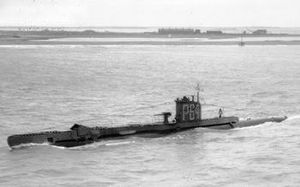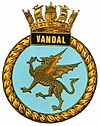HMS Vandal facts for kids

HMS Vandal
|
|
Quick facts for kids History |
|
|---|---|
| Ordered | 15 July 1941 |
| Builder | Vickers Armstrong, Barrow-in-Furness |
| Laid down | 17 March 1942 |
| Launched | 23 November 1942 |
| Commissioned | 20 February 1943 |
| Fate | Sunk in an accident on 24 February 1943 |
| Badge | |
| General characteristics | |
| Class and type | U-class submarine |
| Displacement |
|
| Length | 58.22 m (191 ft 0 in) |
| Beam | 4.90 m (16 ft 1 in) |
| Draught | 4.62 m (15 ft 2 in) |
| Propulsion |
|
| Speed |
|
| Complement | 27-31 |
| Armament |
|
HMS Vandal (P64) was a Royal Navy submarine. It was part of the U-class series. This submarine was built by Vickers-Armstrong in Barrow-in-Furness.
Sadly, HMS Vandal had the shortest career of any Royal Navy submarine. It was lost with all 37 people on board. This happened just four days after it was officially ready for service.
Contents
The Mysterious Loss of HMS Vandal
The submarine, led by Lieutenant James S. Bridger, was on a three-day training exercise. This exercise took place right after the submarine was officially put into service. HMS Vandal was last seen leaving Lochranza on February 24, 1943. Lochranza is in the northern part of the Isle of Arran.
The submarine had just joined the Third Submarine Flotilla. This group was based in Holy Loch, a very important submarine base during World War II. Holy Loch was often used for testing and training.
Searching for the Missing Submarine
At first, there were different ideas about where the submarine might be. One submarine crew thought they saw a smoke candle about 2.5 miles (5 km) north of Inchmarnock. Another crew heard tapping sounds in a similar area.
However, a spotter plane reported a large oil slick. This oil was about 2 miles (4 km) north of Arran. This was about 15 kilometers from Inchmarnock. An investigation at the time did not pay attention to the plane's report. They decided the submarine must have sunk during a deep dive it was supposed to do that day. They thought it was somewhere north of Inchmarnock.
Winston Churchill's Concern
Winston Churchill, who was the Prime Minister at the time, asked for a full report. He wanted to know what happened to the Vandal. He also asked if the submarine had been found.
The reply from the Flag Officer Submarines repeated the wrong idea. They still believed the Vandal was in deep waters off Inchmarnock. They thought it would be impossible to bring it up from there.
Finding the Wreck
In 1994, a group called the Scottish Branch of the Submariners Association finally convinced the Navy to search a new area. This was north of Arran. Several fishing boats had reported their nets getting caught on something underwater there.
A Royal Navy ship, HMS Hurworth, finally found the wreck in June 1994. It was about 300 feet (100 meters) below the surface. The wreck was 1.5 miles (3 km) northwest of Loch Ranza. This was roughly where the spotter plane had first seen the oil slick.
The wreck lies in complete darkness on a muddy slope. It is 100 meters down and tilted to one side. Its forward gun is still covered with a fishing net. The brass letters "VANDAL" can still be clearly seen.
The Sole Survivor's Story
There was only one person who survived from the Vandal crew: Larry Gaines. At the time of the sinking, Gaines was too sick with earache to go on the trip. A younger, less experienced crew member took his place.
For 60 years, Gaines blamed himself for the loss. He thought his replacement might not have closed the back engine room hatch properly. This was one of Gaines's last checks before the submarine would dive.
Later dives to the wreck showed that the back engine room hatch was closed. So, this could not have caused the sinking. Before this, many people thought a mistake, like leaving a hatch open, caused the submarine to sink while diving. However, it was later proven that the submarine was on the surface, not diving, when the accident happened.
The Name Change Superstition
The ship was originally named HMS Unbridled. Before taking command, Captain James Bridger gathered his crew. He told them the ship would officially be known as Vandal. This went against an old tradition among sailors. Changing a ship's name is believed to bring bad luck to the ship and its crew.
Later Investigations and Clues
In August 2003, a team of divers explored the Vandal. They were looking for clues about why it sank. They found that a large part of the back (about 4 feet) was missing. The back engine room escape hatch was closed. However, the front escape hatch was open.
Also, the ropes used for tying the ship were neatly put away. This was true for both the middle and back parts of the ship. The front diving fins were also in their stored position. This suggests that the Vandal was on the surface when the accident happened.
What the Clues Suggest
The area where the Vandal sank is known as "Quebec." Submarines used this area to check their speed logs over a "measured mile." So, it is possible that the Vandal was doing this kind of work. This might explain why it only traveled about 2 miles (4 km) in one and a half hours.
Checking the speed log on a submarine can be very risky. If it is raised for inspection, it could break the strong outer shell of the submarine. This could cause a serious flood. In the case of HMS Untamed, which sank three months after Vandal, a mistake during log maintenance was a major reason for its loss.
If the hull had broken while the front escape hatch was open, a rush of water could have overwhelmed the submarine. The propeller blades on the right side were found to be worn down at their tips. This could mean the propellers were turning (maybe going backward very fast) as the Vandal hit the seabed. Or, they might have been turning while on the seabed to try and move the submarine off the bottom.
This could mean there were survivors in the front parts of the submarine. A report from the Lochranza pier master also supports this idea. He saw smoke candles on the surface. Those who were not killed in the first flood in the back might have tried to use the front escape hatch to leave the submarine. They would have tried to reach the surface, but sadly, they did not succeed.
The submarine was not reported missing until the next morning. Search ships were sent to the area 23 hours later. During this time, a spotter plane saw a small, thick patch of oil over where the Vandal is now known to be. Three hours later, this oil patch had drifted away and spread out. All other hatches and openings to the sea were found to be closed. There were no other signs of damage to the hull or a collision.
Remembering Those Lost
A memorial for those lost on HMS Vandal was put up in 1997. It is next to the Caledonian MacBrayne ferry terminal at Lochranza Pier, Isle of Arran. This was done by the HM Submarines Old Comrades Association.
The wreck of HMS Vandal is a protected site. It is covered by the Protection of Military Remains Act 1986. This law means that divers are not allowed to disturb the site.


